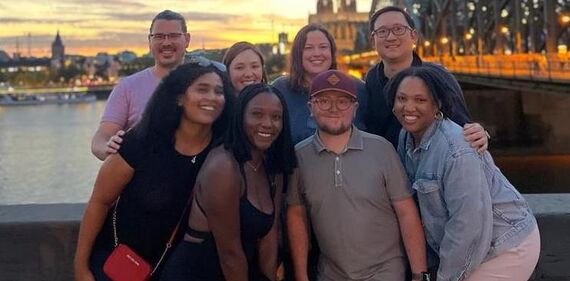
Fieldwork in Bonn and Cologne
Daniela Gonzalez is a Georgetown Global Cities Initiative's Student Scholar and master's candidtate in the Urban and Regional Planning Program.
From September 11th to the 15th, I was part of a group of eight students that visited the cities of Bonn and Cologne, two German cities in the heart of the Rhine-Ruhr region. This trip was the core of a course in the Urban and Regional Planning master's program, titled "Global Metropolitan Planning," taught by Professor Dr. Kenneth Joh. The trip was organized in collaboration with AiB, a German nonprofit dedicated to overseeing study abroad programs in Germany for students from American universities. During our visit to Germany, we had the opportunity to reflect on the nation’s efforts to address climate change and work towards achieving the goal of climate neutrality by 2050, as outlined in the European Green Deal.
Bonn is the southern city of the Rhine-Ruhr metropolitan region, and it used to be the capital of West Germany. This city is renowned as a hub of sustainability as it is the home of several organizations dedicated to this effort such as the United Nations and the German Corporation for International Cooperation (GIZ). Cologne, the fourth most populous city in Germany, is an eclectic city, with a blend of architectural styles from Roman ruins to its iconic Roman Catholic Cathedral, to post-war modernist architecture buildings. Both cities are part of a well-connected metropolitan region with an extensive public transit system and a network of highways.

During our stay in Germany, we engaged with various entities, including Bonn’s City Planning Office, GIZ, Dr. Bolte from Bonn University, and Dr. Juliane von Hagen, an urban researcher and urbanist who acted as our guide throughout the week. These interactions provided insights into diverse aspects of urban planning and how Germany aligns its strategies with the Sustainable Development Goals (SDGs).
When reflecting, there were many important points, but I want to emphasize four that were the most heavily discussed in class. First, the German transportation network, while impressive in its multimodality, showed occasional flaws in terms of reliability. Despite these issues, there exists a robust culture of public transit in the region. Unlike the United States, where car ownership dominates, Germany demonstrates a more balanced modal split, incorporating public transit, cycling, and walking into daily commuting. Second, the regional cooperation within the Rhine-Ruhr region was remarkable. Cities, each with a population not exceeding one million, collaborated effectively as a single metropolitan region. This collaboration allows them to sustain growth while retaining opportunities present in megacities.
A third point was the transformation of the region from a heavily industrial to a post-industrial region, serving as an open laboratory for the multiple challenges of urbanization, migration, and climate change. Dr. von Hagen introduced us to initiatives by the German Government aimed at repurposing industrial city ruins, a subject that could hold relevance for the United States, where numerous cities have experienced post-industrial decline. The final point involved the region’s preparedness for climate change. We visited the Arh Valley, a region that experienced severe flooding in 2021. It seemed like in the subject of climate disasters, Germany had lessons to learn from the United States, a nation unaccustomed to severe climate-related events.

One of the most personally rewarding experiences was our visit to Nachbarn 60, a car-free housing complex with more than 15,000 residents in Cologne. This innovative housing model required intricate legal work to be materialized. The residents of this site enjoyed a strong sense of community, sharing amenities like a car rental program, spaces they could reserve for social interactions, communal storage, diverse housing options from public housing to owned single-family homes, a community garden, and public spaces reserved for walking, cycling, and playing. Instead of parking, this site is filled with bikes from people at all stages of their lives. Additionally, there seems to be a sense of peace in the diversity of the population that lives there.
To conclude, our journey to Germany provided a remarkable insight into how a country, similar to the United States in many aspects, including high per-capita incomes, car ownership rates, driver licensing rates, and quality road networks, addresses climate change and equity in a strikingly different manner from the United States. This journey has broadened our horizons, offering valuable insights into the strength of Germany's public transit culture, regional cooperation, and post-industrial transformation. The knowledge we have gained will undeniably impact our future academic and professional pursuits, motivating us to advocate for sustainable, inclusive, and resilient communities.



